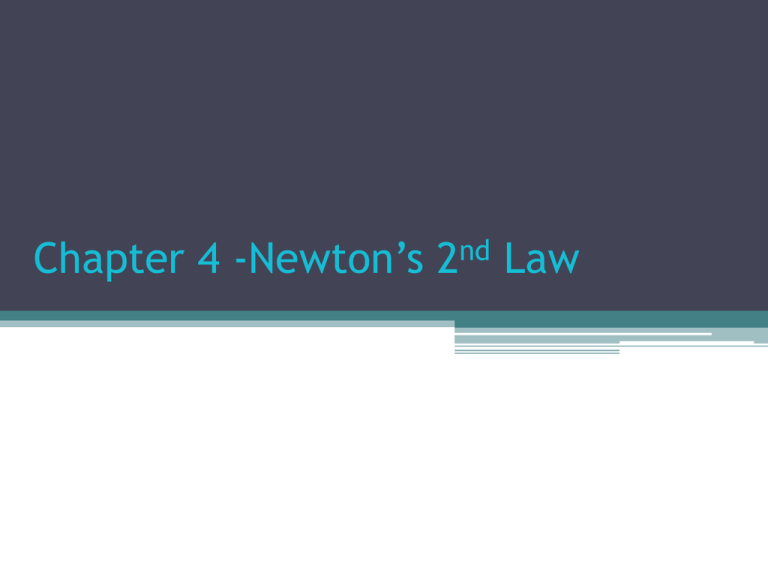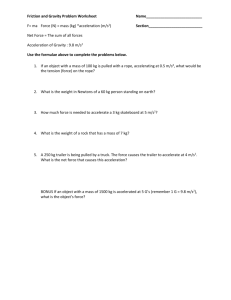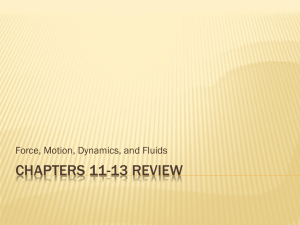Forces & Newton's Laws Ch. 4, 5, & 6
advertisement

Chapter 4 -Newton’s 2nd Law Force Causes Acceleration • We learned w/ the 1st Law that objects do not like changes in their motion… ▫ if a net force is applied to an object the motion of an object will change… • ‘changing motion’ basically means the same thing as Acceleration • So then we can say…. ‘force causes acceleration’ Friction • Force Caused by irregularities between surfaces that are in contact with each other • Always directed opposite motion • Rolling Friction<Sliding Friction < Static Friction • Air Resistance is another kind of friction Amount of Friction… • Depends on ▫ Weight of the object ▫ How rough or smooth the surfaces in contact are • Does not depend on ▫ Surface area of object ▫ Speed of the object Mass & Weight • Mass (m) ▫ How much matter is in an object ▫ A measure of an object’s inertia ▫ Mass never changes depending on location Same everywhere • Weight (Fg) ▫ ▫ ▫ ▫ How much gravity is pulling on an object Aka… The FORCE of gravity acting on an object Depends on how strong gravity is can change from place to place…. How to determine an object’s weight? • Mass and weight are always directly proportional • We find weight by using the equation • Weight = mass x acc. of gravity • Or.. Fg = mg • g = 10 m/s2 • an object has a mass of 1 kg has a weight of be 10 Newtons. • The “Newton” is the standard unit for force, and since Weight is a force, the Newton is used here. • 1 N = 1 kg*m/s2 Mass resists acceleration • All forces do not accelerate all objects equally • Objects with more mass are more difficult to accelerate, and thus require more force Newton’s 2nd Law • ‘The acceleration of an object is directly proportional to the net force on it, and inversely proportional to its mass’ • This means…. The larger the force, the larger the acceleration • AND …. The larger the mass, the smaller the acceleration • This can be summed up w/ the equation • ∑F=ma • a acceleration (m/s2); ∑FNet Force (N); mmass (kg) Newton’s Second Law • Q - When 2 kg stone is thrown it is given an acceleration of 20 m/s2. What is the net force applied to the ball? • A - Fnet = ma = (2 kg) x (20 m/s2) = 40 N • Q- What is the weight of an object with a mass of 70 kg? • A- Fg = mg = 70kg x 10 m/s2= 700 N • Q- What is the mass of an object that has a weight of 1000 N? • A- Fg=mg so m = Fg/g = 1000N/ 10m/s2= 100 Kg Free Fall Acceleration – Why don’t heavier objects fall faster? • Newton’s 2nd says that the more force an object has on it the faster it should accelerate….. So then if heavier objects have a larger weight (force of gravity), why do they not accelerate faster? ▫ Ans. True, heavier objects have more force, but they also have more mass, which means that it requires more force to accelerate as fast as lighter objects…. ▫ Essentially…. The larger force and larger mass cancel each other out ▫ All falling objects accelerate downward at 9.8 m/s2 Non FreeFall Air Resistance Depends on 2 things… Frontal area of the falling object How fast object is moving There is a point where a falling object is going so fast the air resistance becomes so strong that the object can no longer accelerate….. This speed is called terminal speed Object is still falling, but no longer accelerating In most problems we ignore any effects of air resistance • Heavier parachutist must fall faster in order for air resistance to cancel out his weight Skydive / Free Fall Record • Kittinger- 1960 ▫ Video • Failed attempts • Failed Skydive Attempt • Skydiver • RedBull Stratos Project • Red Bull Stratus Project • http://www.space.com/7824-skydiver-plans-supersonic-jump-edgespace.html • http://spacejump.co.uk/history.htm • http://www.popularmechanics.com/technology/aviation/safety/space-divethe-race-to-jump-from-120000-feet • Other project details • Videos




